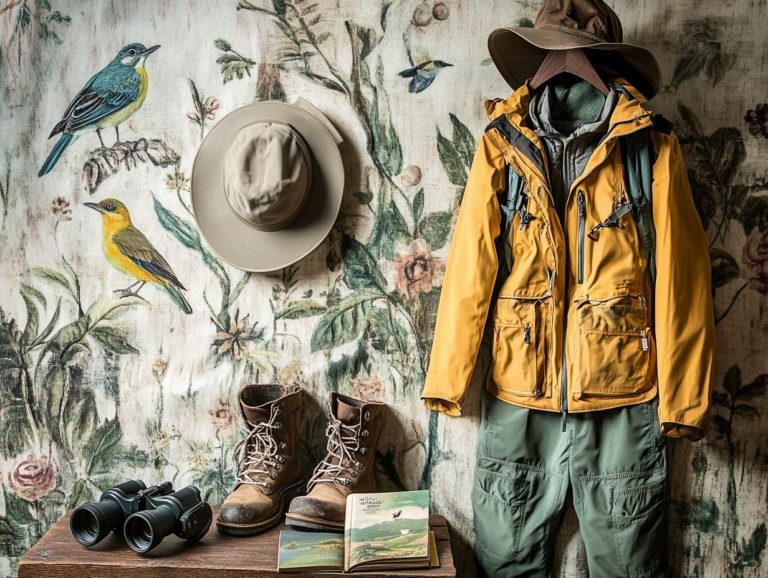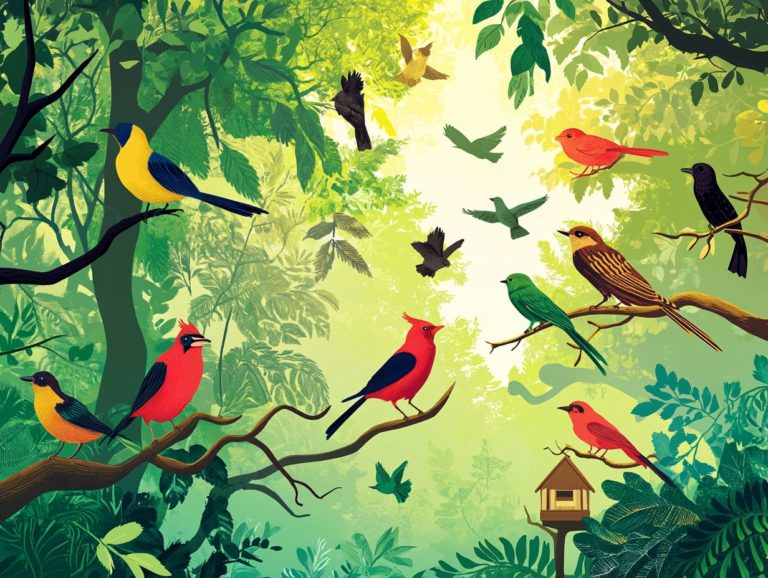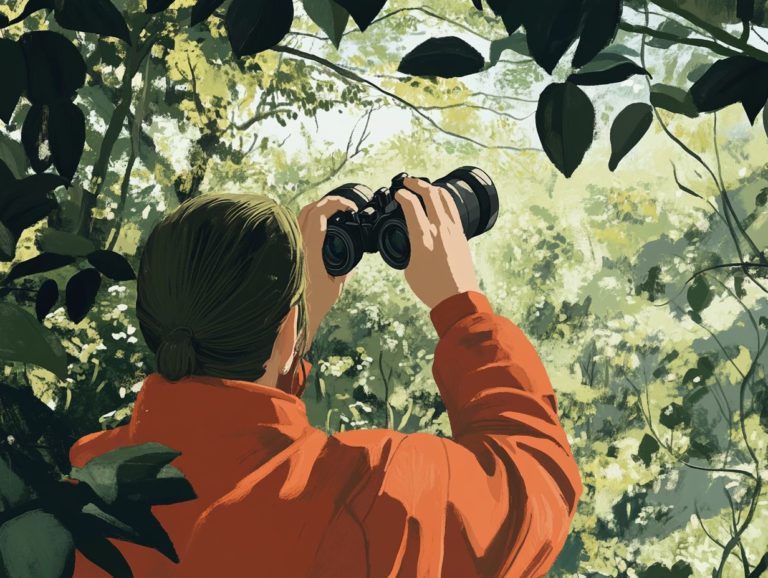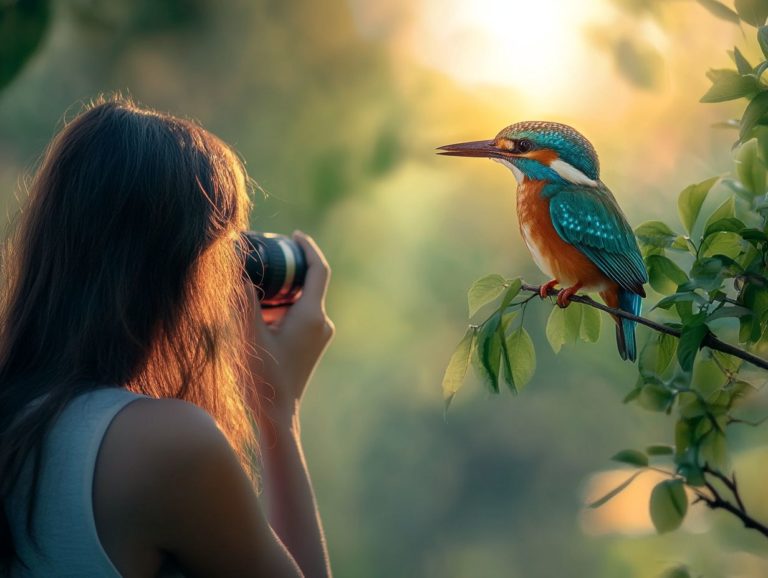5 Common Bird Watching Mistakes in Grasslands
Birdwatching in grasslands can be rewarding. However, mistakes can detract from your enjoyment.
Common errors include not researching the area or lacking proper equipment.
This article highlights five pitfalls and provides tips on how to prepare effectively.
Contents
- Key Takeaways:
- 1. Research the Area Beforehand
- 2. Not Bringing the Proper Equipment
- 3. Not Being Patient Enough
- 4. Not Knowing the Birds’ Behaviors
- 5. Not Respecting the Birds’ Habitat
- How Can You Prepare for a Successful Bird Watching Trip?
- Frequently Asked Questions
- Avoid These 5 Common Bird Watching Mistakes in Grasslands!
- Why is it Important to Research the Area Before Bird Watching in Grasslands?
- How can binoculars improve my bird watching experience in grasslands?
- Why is patience important in bird watching in grasslands?
- What is the recommended distance to keep from birds in grasslands?
- How can I show respect for the environment while bird watching in grasslands?
Key Takeaways:
- Research the area before your birdwatching trip.
- Bring necessary gear like binoculars and field guides.
- Be patient and take your time to observe bird behavior.
1. Research the Area Beforehand
Knowing your birdwatching site increases your chances of spotting birds. Lack of knowledge leads to missed opportunities.
Learn about popular birdwatching spots, their habitats, and seasonal behaviors. This knowledge is essential for identifying birds.
For example, the wetlands in Everglades National Park host a variety of wading birds, like the Great Egret and the Roseate Spoonbill.
Use resources like field guides—books that help you identify different kinds of birds—and online birding forums to gather information. Look for local birding groups on social media for up-to-date sightings.
2. Not Bringing the Proper Equipment
The right equipment is crucial for a successful birdwatching trip. Using the wrong gear can hinder your ability to identify birds accurately.
Essential items for birdwatching trips include:
- Binoculars
- A field guide—such as the Sibley Guide or Peterson Guide—tailored to local bird species
- A high-quality camera for documenting your sightings
Good binoculars allow you to observe birds from a distance and aid in identification. Regularly adjusting the focus and keeping the lenses clean can prevent frustration.
A good field guide provides key information about native species, enabling quick identifications. While a camera can capture fleeting moments, knowing how to use it and making quick adjustments is vital.
Bringing snacks, staying hydrated, and being patient while observing nature also contribute to a successful trip.
3. Not Being Patient Enough
Birdwatching requires patience. Rushing through the experience often results in missed sightings and diminished enjoyment.
Setting realistic expectations can change your perspective. Rather than trying to spot every species in one outing, focus on a few to enhance your observational skills.
Practicing mindfulness during these excursions helps you tune into the subtle sounds of nature and observe the delicate movements of birds.
A seasoned birdwatcher recalls a serene morning spent quietly waiting near a feeder. The first glimpse of a rare species brought an exhilarating thrill unlike any other. This experience shows how patience can lead to incredible memories you’ll cherish forever!
4. Not Knowing the Birds’ Behaviors
Understanding bird behaviors is essential for birdwatching. It helps birders identify different species and appreciate their seasonal habits and habitat preferences.
This knowledge is particularly important for distinguishing between species such as the Greater Yellowlegs and the Lesser Yellowlegs, as well as raptors like the Northern Goshawk and Cooper’s Hawk.
Birders who dedicate time to observing and researching these behaviors learn to recognize various foraging, hunting, flight, and communication techniques that facilitate identification. For instance, the Greater Yellowlegs typically forages alone and has a distinctive loud call. In contrast, the Lesser Yellowlegs is more commonly found in flocks.
The Northern Goshawk uses a stealthy approach when hunting, while the Cooper’s Hawk relies on quick maneuvers through dense cover.
Familiarity with these behaviors enhances birders’ abilities to identify and enjoy birds in their natural habitats.
5. Not Respecting the Birds’ Habitat
Respecting birds’ habitats is a crucial aspect of birdwatching. Disturbances can negatively impact local wildlife and detract from the overall birding experience.
Birders can preserve habitats by following best practices. Simple actions, such as using established paths, maintaining a safe distance from nests, and speaking quietly, can significantly reduce stress for local birds.
Keeping detailed logs or journals of birdwatching activities helps passionate birders recall their sightings. It also provides an opportunity to reflect on whether their presence may have disturbed the habitat.
This reflection fosters a deeper connection with the ecosystem, benefiting both the birds and the birders.
How Can You Prepare for a Successful Bird Watching Trip?
Get ready for your birdwatching adventure! The key factors for a successful trip include checking your equipment, knowing local birding spots, and being aware of essential elements that enhance overall birding experiences.
These factors should be included in a trip checklist to ensure a successful outing. Researching local birding sites is crucial for understanding the different habitats in your area.
It also helps determine the best times to visit them. While packing necessary equipment such as binoculars, a field guide, and a notebook to record your sightings is important, don’t forget to include water, snacks, and clothing suitable for your location and the season.
Planning your trip in terms of transportation, travel time, and the distance you will need to hike to see your target birds can significantly improve both your effectiveness and enjoyment.
What Are Some Essential Equipment for Bird Watching?
Don’t miss out on these essentials! Essential equipment for a birdwatching trip includes high-quality binoculars, a reliable field guide such as the Sibley Guide or Peterson Guide, and, if desired, a good camera.
- Binoculars: The best binoculars for birding should have at least 8x magnification and a wide field of view. This allows you to quickly locate and follow fast-moving birds. Lightweight and waterproof binoculars are particularly beneficial in wet weather conditions.
- Camera: A good camera with a zoom lens is helpful for documenting wildlife that may be too secretive or shy to be seen out in the open. Smartphone attachments can serve as a more affordable alternative.
- Choosing Equipment: When selecting gear, consider personal preferences, such as ease of transport, learning curve, and cost. This will help create a birding experience tailored to individual needs.
What Are Some Tips for Being Patient While Bird Watching?
Patience is essential for enhancing your bird-watching skills and fully enjoying the experience. Here are some strategies to help you cultivate patience:
- First, minimize distractions by leaving your phone in the car. Immerse yourself in the environment. This approach can transform your bird-watching outing into a meditative experience, allowing you to notice the subtle movements of leaves and the soft trill of distant songbirds.
- Next, focus on your surroundings. This attentiveness helps you appreciate the small details in nature and fosters patience.
- You can also use simple breathing exercises to keep yourself grounded in the present moment.
Imagine the electrifying moment when that rare bird finally appears after your hour of waiting! The thrill of spotting it makes every second spent watching the clock worthwhile, reminding you that good things often come to those who wait.
How Can You Learn About Birds’ Behaviors?
Observing bird behaviors is crucial for identifying different species and understanding their seasonal habits and habitats. This knowledge can be documented in journals for further study. In addition to directly observing birds in nature, you can engage with forums, explore educational websites, and keep your own journal.
Various observation techniques, such as quietly sitting in a hide (a birdwatching shelter), or using binoculars to watch from a distance, provide valuable insights into birds’ lives. Online birdwatching forums and educational sites offer access to expert articles, videos, and photo galleries that enhance the learning experience.
Keeping a journal allows you to document behaviors, creating a personal record that facilitates reflection on changes over time. This practice can lead to a deeper appreciation of bird life and its natural rhythms.
How Can You Minimize Your Impact on Birds’ Habitats?
Minimizing your impact on birds’ habitats is essential for ethical birding. Being aware of your influence can significantly reduce disturbances and promote sustainability. Birders can achieve this by:
- Sticking to designated paths: Most damage to fragile flora and natural bird habitats results from people walking in unauthorized areas, disrupting nesting sites and harming the local ecosystem.
- Knowing and respecting distances to nests: It is crucial for the long-term health of bird populations that individuals understand and adhere to necessary distances from nests. This practice protects the birds and enhances the survival chances of their young. Many local regulations are in place for this reason.
- Educating other birders and the broader community: Promoting awareness about these issues can enhance their effectiveness. When ethical and respectful practices become ingrained within a community, it contributes to a healthier ecosystem for birds.
What Are Some Common Misconceptions About Bird Watching?
Bird watching is often accompanied by misconceptions that can lead to avoidable mistakes. Understanding these myths is essential for enriching your birding experience and gaining valuable insights.
Many people believe that high-end binoculars or elaborate photography equipment are necessary to truly appreciate this serene hobby. However, even a simple pair of binoculars can provide a remarkable view of local bird species.
Additionally, novice birders may assume that certain birds are always easy to find, overlooking the fact that factors such as habitat, time of year, and local weather can significantly influence sightings.
By debunking these myths, individuals can embark on their birding adventures with greater confidence and reduced frustration, ultimately deepening their connection to nature.
Frequently Asked Questions
Avoid These 5 Common Bird Watching Mistakes in Grasslands!
The 5 common bird watching mistakes in grasslands are: not researching the area, not using binoculars, not being patient, not keeping a safe distance, and not respecting the environment.
Why is it Important to Research the Area Before Bird Watching in Grasslands?
Researching the area allows you to understand the types of birds that can be found there and their behaviors, increasing your chances of spotting them.
How can binoculars improve my bird watching experience in grasslands?
Binoculars let you see birds up close. This helps you identify them and appreciate their features.
Why is patience important in bird watching in grasslands?
Birds can be tricky to spot. Be patient and observe your surroundings closely.
What is the recommended distance to keep from birds in grasslands?
Stay at least 50 feet away from birds. This helps avoid disturbing their natural behaviors.
How can I show respect for the environment while bird watching in grasslands?
Respect the environment by not disturbing birds or littering. Follow local rules to help protect their natural habitat.
Grab your binoculars and get ready for an incredible birdwatching adventure!




